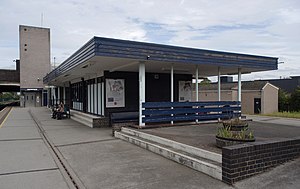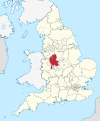Burton-on-Trent railway station
 | |
| General information | |
| Location | Burton upon Trent, Staffordshire England, United Kingdom |
| Ordnance Survey National Grid | SK242232 |
| Managed by | East Midlands Railway |
| Platforms | 2 |
| Other information | |
| Station code | BUT |
| Classification | DfT category D |
| Passengers | |
| 2018/19 | |
| Interchange | 10,645 |
| 2019/20 | |
| Interchange | |
| 2020/21 | |
| Interchange | |
| 2021/22 | |
| Interchange | |
| 2022/23 | |
| Interchange | |
| Notes | |
Passenger statistics from the Office of Rail and Road | |
Burton-on-Trent railway station is a mainline railway station located in the town of Burton upon Trent, Staffordshire, England. It is owned by Network Rail and managed by East Midlands Railway, although only CrossCountry services call at this station.
History[edit]




First station (1839-1883)[edit]
The original Burton on Trent station was opened in 1839 by the Birmingham and Derby Junction Railway on its original route from Derby to Hampton-in-Arden meeting the London and Birmingham Railway for London. The station originally consisted of a hut and an adjacent level crossing. A more substantial two-storey building was later constructed.[1]
Second station (1883-1970)[edit]
In 1881, an increase in passengers and goods using the railway led to the old station being demolished and a temporary island platform constructed. A new station was constructed 150 yards further south and separated from the roadway on the bridge by iron palisading. There was a large covered cab-stand, which offered access to the booking hall, 65 ft wide, 27 ft deep and 35 ft high in the early English style, partly timbered. The stairs provided access to the island platform on which were built waiting rooms for ladies and gentlemen, and a first-class refreshment and dining room and a third-class refreshment room. A WH Smith newsagent stall was also located on the platform. The platforms were covered with a glass canopy and extended close to one-quarter of a mile in length. The station was designed by the company architect John Holloway Sanders and erected by Messrs Cox of Leicester. The bridge was constructed under the supervision of the company engineer, Mr. Campion.[2] The new station re-opened in 1883.
Until the 1960s the station also served as the terminus for a number of secondary routes, such as the South Staffordshire line to Lichfield City, the Leicester–Burton upon Trent line to Leicester via Coalville Town and to Tutbury and Hatton. These all closed to passenger traffic between 1960 and 1965.
Third station (1970-present)[edit]
As part of the British Railways modernisation plans, the station was rebuilt again in 1970. Of the previous station, only the staircase down to platform level remains. During the summer and autumn of 2011, the station underwent a £700,000 refurbishment, including removal of asbestos, improved facilities for disabled people, improved lighting and a refurbished waiting room.[3]
In late 2019, the forecourt in front of the station was redeveloped to add a new taxi rank and bus departure bays.[4]
Station Masters[edit]
- J. Hackett ca. 1850
- Mr. Harrison 1860 - 1866[5]
- Joseph Heaton 1866 - 1870[6]
- Joseph Hawkins 1871 - 1893
- George Cook 1893 - 1901[7] (afterwards station master at Derby)
- John Morton Jacques 1901[8] - 1916 (formerly station master at Market Harborough)
- Thomas Pitt 1916[9] - 1922 (formerly station master at St Albans)
- Harry l’Anson 1922 - 1927[10]
- John Winnington 1927 - 1928
- Arthur Ernest Chandler 1928[11] - 1932 (formerly station master at Cheltenham, afterwards station master at Leeds)
- T. W. Leach 1932 - 1938 (formerly station master at Mansfield)
- E. A Stafford 1938 - 1942
- E. Nadin 1942 - 1944 (formerly station master at East Ham)
- Frank J. Mayall 1944 - 1947 (afterwards station master at Derby)
- H. F. J. Lyons 1947 - 1950[12] (formerly station master at Plaistow)
- J.W. Dodd 1950[13] - ????
- George R. Hemming 1957 - 1960[14] (afterwards station master at Northampton)
- Frank Sutcliffe 1960[15] - 1964 (formerly station master at Hebden Bridge)
Facilities[edit]
Access to the station is from the bridge on Borough Road which crosses the railway line. At road level, there is a taxi rank, a shop and the station entrance which contains the ticket office. In order to reach the two platforms, passengers descend a broad staircase. A lift is also available.
Only a single building now stands at the platform level (Burton is an island station where the tracks run around a single platform) and this building incorporates a waiting room, toilets and a dispatcher's office. Timetable information is available from destination boards and real-time customer information screens with automated train announcements. There is a ramp for step-free access between the two platforms.
The station has the PlusBus scheme where train and bus tickets can be bought together at a saving.
Motive power depot[edit]
As a centre for beer brewing, Burton generated a great deal of freight traffic. Burton itself was criss-crossed by the lines of the brewery companies' private lines with a plethora of level crossings. In 1870 a new locomotive shed was built to the south of the station. This consisted of a roundhouse built round a 42-foot (13 m) turntable. In 1892 another roundhouse was added with a 50-foot (15 m) turntable. In 1923 these were replaced by 57-foot (17 m) and 55-foot (17 m) turntables respectively. Originally coded "2" by the Midland Railway, it became 17B in 1935.
By 1948 the depot had 111 locomotives allocated to it. With the arrival of diesel locomotives, [citation needed] a reorganisation of motive power districts in the London Midland Region took place in September 1963.[16] Under this, the former Nottingham (16), Derby (17) and Toton (18) divisions were amalgamated, with Toton as the main shed for the division; this was coded 16A,[16] and Burton-on-Trent became 16F.[17] Steam traction was removed from this depot in September 1966 [17] and it closed to steam in 1968, but carried on for diesel locomotive fuelling and stabling.
Services[edit]
Burton station lies on the Cross Country Route between Derby and Birmingham New Street. All services that stop here are provided by CrossCountry.
Trains between Cardiff, Birmingham and Nottingham generally call here every hour in each direction.
Long-distance inter-city services, between the north-east and south-west, call here approximately once per hour or once every two hours each direction; these operate northbound towards Aberdeen, Edinburgh, Leeds, Newcastle or York and southbound to Bristol Temple Meads, Penzance or Plymouth.[18]
The station is managed by East Midlands Railway, although none of their trains call here.
| Preceding station | Following station | |||
|---|---|---|---|---|
| CrossCountry | ||||
| CrossCountry | ||||
| Preceding station | Disused railways | Following station | ||
|---|---|---|---|---|
Line and station closed | Great Northern Railway | Terminus | ||
| Disused railways | ||||
| Terminus | Midland Railway Swadlincote Loop Line |
Swadlincote Line and station closed | ||
| Historical railways | ||||
| Terminus | Midland Railway | Line open, station closed |
||
| Branston (Staffordshire) Line open, station closed |
Midland Railway Birmingham and Derby Junction Railway |
Willington | ||
Future[edit]
It has been proposed in the past that the line between Burton and Leicester, known as the Ivanhoe Line, to be reopened for passenger use.[19] Services had originally been withdrawn in 1964 due to the Beeching Axe, though the line is still open for freight traffic. In January 2019, an action group called Campaign to Re-Open The Ivanhoe Line (CRIL) was formed in Swadlincote to campaign for the reopening of the line.[20]
In June 2019, the Derby Telegraph published an article showing support for the reopening of the South Staffordshire Line for trams.[21] According to the article, London-based consultants Cushman and Wakefield had put forward suggestions to both Staffordshire County Council and East Staffordshire Borough Council to look at bringing trams into Burton to promote tourism and businesses.
In literature[edit]
The station, the railway sheds and the town's popular trainspotting locations feature significantly in the autobiographical book, Platform Souls by local author Nicholas Whittaker.
References[edit]
- ^ Twells, H.N. (1997). The Railways in and Around Burton upon Trent, p. 11. Challenger Publications. ISBN 1899624287.
- ^ "The new Midland Railway Station at Burton-on-Trent". Derby Daily Telegraph. British Newspaper Archive. 30 April 1883. Retrieved 6 July 2016.
- ^ Taylor, Josh (6 September 2011). "£700,000 railway station makeover is under way". Burton Mail. Archived from the original on 4 April 2012. Retrieved 9 September 2011.
- ^ Moody, Jenny. "Good news for drivers as major Burton road finally reopens", Burton Mail, 4 November 2019. Retrieved on 15 January 2020.
- ^ "Presentation". Derby Mercury and Express. England. 10 October 1866. Retrieved 5 December 2017 – via British Newspaper Archive.
- ^ "Presentation". Staffordshire Advertiser. England. 31 December 1870. Retrieved 16 September 2017 – via British Newspaper Archive.
- ^ "Midland Railway Official Changes". Derby Daily Telegraph. England. 30 September 1901. Retrieved 16 September 2017 – via British Newspaper Archive.
- ^ "The recent staff changes on the Midland". Derby Daily Telegraph. England. 17 October 1901. Retrieved 16 September 2017 – via British Newspaper Archive.
- ^ "The new M.R. stationmaster at Burton". Derby Daily Telegraph. England. 20 December 1916. Retrieved 16 September 2017 – via British Newspaper Archive.
- ^ "Burton's New Stationmaster". Derbyshire Advertiser and Journal. England. 22 April 1927. Retrieved 16 September 2017 – via British Newspaper Archive.
- ^ "Burton Station-Master". Nottingham Journal. England. 31 August 1928. Retrieved 16 September 2017 – via British Newspaper Archive.
- ^ "Retirement of Mr. H.F.J. Lyons". Derby Daily Telegraph. England. 26 July 1950. Retrieved 16 September 2017 – via British Newspaper Archive.
- ^ "New Burton Station Master". Burton Observer and Chronicle. England. 12 October 1950. Retrieved 8 April 2021 – via British Newspaper Archive.
- ^ "Mr. George R. Hemming". Burton Observer and Chronicle. England. 31 March 1960. Retrieved 8 April 2021 – via British Newspaper Archive.
- ^ "Burton's New Station Master". Burton Observer and Chronicle. England. 12 October 1960. Retrieved 8 April 2021 – via British Newspaper Archive.
- ^ a b Walford, John (2012). A Detailed History of British Railways Standard Steam Locomotives. Vol. Five: The End of an Era. Maidenhead: RCTS. p. 13. ISBN 978-0-901115-97-3.
- ^ a b Walford 2012, p. 18
- ^ "Train Timetables | Scotland, North East & Manchester to the South West and South Coast | Sunday 10 December 2023 – Saturday 01 June 2024" (PDF). CrossCountry Trains.
- ^ Leicestershire County Council - Ivanhoe Line Stage II Scheme Re-AppraisalLeicestershire County Council Report April 2009; Retrieved 2014-01-23
- ^ Waldron, Ben. "Action group forms to reopen historic railway line", Burton Mail, 25 January 2019. Retrieved on 15 January 2020.
- ^ Kreft, Helen. "Tram trains could be key to bringing new jobs to Burton", Burton Mail, Burton upon Trent, 20 June 2019. Retrieved on 15 January 2020.
Further reading[edit]
- Mitchell, Vic; Smith, Keith (2016). Derby to Stoke-on-Trent. West Sussex: Middleton Press. figs. 80-83. ISBN 9781908174932. OCLC 954271104.
External links[edit]
- Train times and station information for Burton-on-Trent railway station from National Rail
- Railway stations in Staffordshire
- DfT Category D stations
- Former Midland Railway stations
- Railway stations in Great Britain opened in 1839
- Railway stations in Great Britain closed in 1883
- Railway stations in Great Britain opened in 1883
- Railway stations served by CrossCountry
- Burton upon Trent
- 1839 establishments in England
- 1883 disestablishments in England
- Railway stations in Great Britain not served by their managing company

